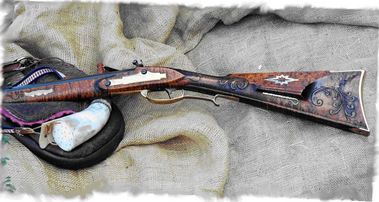
Lancaster School of Gunsmithing

The Lancaster School of gunsmithing originates from Lancaster Borough, Pennsylvania. I have seen notes in historical data about a Lancaster Township, a Lancaster County, and the city of Lancaster. All roads of the Kentucky rifle begin here. The central part of Pennsylvania was settled by German immigrants, some Scotch-Irish and English Quakers. The Germans brought their Jaeger, the English and Scotts brought the smoothbore long barreled fowlers. Out of this conglomeration of culture was born our Kentucky rifle. So, it stands to reason that we went through a design phase we now call a transition rifle. Next was the early rifle styles from Lancaster we naturally call the Early Lancaster. It was the beginning of a beautiful rifle and the period which would be known as the Golden Age.
The Early Lancaster rifle began with a heavier buttstock influenced by the thick butt of the Jaeger. The patchbox was originally the wooden sliding lid with long spring installed in its top. The buttplates were around 1-7/8” thick, flatter and were beaten into shape from cast brass. The nosecaps were of flattened cast brass, then folded around a piece of barrel, and the brass folded and hammered over the end of the form. The shape was then filed to finish. Edges were as sharp as possible. Most mountings were of this pure cast brass. Only the best craftsmen knew the art of casting, and most mountings were bought or traded for from the French or English.
The length of the barrels was originally forced by the need for improved accuracy, whether at the enemy or wild game that was learning to stay farther away. Our first rifles were smoothbores in small calibers. They were later rifled. Thus the assorted finds of octagon to round barrels in the smaller calibers of .38, .41, .48, .52, etc. and the lengths of these barrels getting longer and longer.
These Early Lancaster rifles are generally prior to 1800. Earlier guns are hardly ever signed and those that fall within the correct period are designated as Pre-Revolutionary. Pre-Rev Kentuckys with wooden patch box lids have certain features. Broader than high wrists, a high straight comb and high cheek pieces, and pinned barrels are a few details. Carving and engraving started here and was influenced again by English styles and Germanic makers.
Some early makers of the Lancaster School:
P. Brong, J. Brooks, Jacob Dickert, M Fordney, P. Gonter, J. Metzger and P. Resor